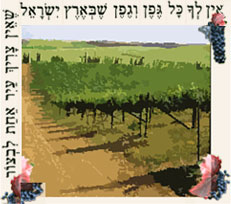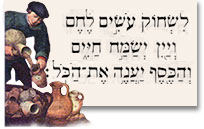|
JHOM - Wine - History of Viticulture

Second
Temple Period

| Coin (dinar) from Bar Kokhba period (2nd
cent. CE) |
|
During the Second
Temple period, the economy of the Land of Israel was principally agricultural.
Wheat and particularly barley were produced in such quantities that, despite
the great population density, enough was produced in good years to sustain
the heavy burden of taxation in kind exacted by foreign rulers and, in
addition, even have cereals for export.
Even the Egyptian author of the "Letter of Aristeas" extolled Judea's
high agricultural productivity. Some rabbis boasted, with homiletical recklessness,
that in blessed years the poorest region of Palestine gave a larger crop than
the richest part of Egypt, which from time immemorial had been the granary of
the Mediterranean world.

| There is not a vine in the land of Israel whose harvesting
does not require the labor of a whole town. (TB Ketubbot 111b)
|
Still richer was the fruit
crop. As Plutarch, Pliny and other classical writers tell us, Palestinian dates,
figs, olives and grapes, wine and oil were of superior quality and prized even
in other Mediterranean countries rich in these products. They were served on
the imperial tables in Rome. With truly oriental abandon a rabbi contended that
"there is not a vine in the land of Israel whose harvesting does not require
the labor of a whole town." Another explained his three-day absence from
his job by saying, "My father left me a vine branch from which I harvested
on the first day three hundred clusters, each yielding a barrel. On the second
day, I cut three hundred clusters yielding half a barrel each. On the third
day, the three hundred clusters produced one-third barrel each and I still left
behind more than half of the crop." (TB Ketubot 111b)[1]
| By the 15th century few Jews still owned
vineyards and produced their own wine, but trade in wine and liquor was
becoming a major Jewish occupation in Germany and the Slavic countries.
The competition from Jews was often serious enough to cause local guilds
to complain about it. At times, this commerce was developed in combination
with money lending. |
Medieval Western Europe
As Jews moved from the more advanced Mediterranean countries into newer areas
of settlement in the Middle Ages (especially Spain, France and Germany) they
could employ more refined techniques in the cultivation of old [crops] and introduce
new crops, to their own and society's advantage. Jews were often attracted to
agriculture because of the opportunities opened here for their pioneering efforts..…
While rabbinic sources mention Jews raising grain, most Jewish farmers seem
to have devoted themselves to viticulture, the cultivation of orchards or dairy
and truck farming, all of which required a larger initial investment of capital
and labor, but later yielded higher returns on limited areas.

| They make a banquet for revelry; wine makes life merry
and money answers every need. (Ecclesiastes 10:19) |
|
For Jews, [viticulture]
appeared doubly attractive, as grapes could be cultivated in the immediate
vicinity, or even within the confines of many medieval towns. After the
initial plantings, vineyards and orchards require more intelligent supervision
than constant labor. Hence, even scholars like Rashi could grow grapes
for a living, while devoting their main attention to research and teaching.
Rashi's grandson, Jacob Tam, though a prosperous moneylender and possibly a
tax farmer, also engaged in the cultivation and the production of wine.
This practical experience taught him to be less stringent with respect
to the laws of "wine of libation." On one occasion he justified
his liberal interpretation by saying: "Wherever a considerable financial
loss is involved the Torah always evinces concern for Israel's money.
Should I not evince such concern, and refuse to decide that the matter
is permitted?"
Medieval Spain
| In medieval Spain (both Muslim and Christian),
the sale and consumption of wine were taxed by the autonomous Jewish communal
administration. |
Jews emigrating from Muslim lands easily transplanted the same methods, especially
to countries of comparable climatic conditions such as northern Spain, Provence
and parts of Italy. The nascent states of Leon and Castile, Aragon and Catalonia,
as well as those of neighboring Provence therefore welcomed and fostered Jewish
land-ownership, and even the Church raised few objections. Many 10th-12th churches
and monasteries are even recorded as collaborating with Jews in developing newly
recovered lands.
[A claim has even been made]
though with much exaggeration, that between the tenth and twelfth centuries
Jews owned one third of all of the land around Barcelona. On their part, Jews,
whose ownership of entire villages is attested by the frequency of such designations
as allodium Judaicum or mons Judaicus or those derived from al-yehud
or yahudi, developed that attachment to the soil characteristic of persons
born and bred on it…[2]
|
[1]Salo
Baron, A Social and Religious History of the Jews. Volume I, New York:
Columbia University Press. 1957. pages 250, 51. [back]
 [2]
Salo
Baron, A Social and Religious History of the Jews. Volume IV Meeting of
East and West, New York: Columbia University Press. 1957. [back] [2]
Salo
Baron, A Social and Religious History of the Jews. Volume IV Meeting of
East and West, New York: Columbia University Press. 1957. [back]
|
WINE
Table of Contents
|



